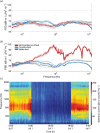Soundscape enrichment increases larval settlement rates for the brooding coral Porites astreoides
- PMID: 38481984
- PMCID: PMC10933538
- DOI: 10.1098/rsos.231514
Soundscape enrichment increases larval settlement rates for the brooding coral Porites astreoides
Abstract
Coral reefs, hubs of global biodiversity, are among the world's most imperilled habitats. Healthy coral reefs are characterized by distinctive soundscapes; these environments are rich with sounds produced by fishes and marine invertebrates. Emerging evidence suggests these sounds can be used as orientation and settlement cues for larvae of reef animals. On degraded reefs, these cues may be reduced or absent, impeding the success of larval settlement, which is an essential process for the maintenance and replenishment of reef populations. Here, in a field-based study, we evaluated the effects of enriching the soundscape of a degraded coral reef to increase coral settlement rates. Porites astreoides larvae were exposed to reef sounds using a custom solar-powered acoustic playback system. Porites astreoides settled at significantly higher rates at the acoustically enriched sites, averaging 1.7 times (up to maximum of seven times) more settlement compared with control reef sites without acoustic enrichment. Settlement rates decreased with distance from the speaker but remained higher than control levels at least 30 m from the sound source. These results reveal that acoustic enrichment can facilitate coral larval settlement at reasonable distances, offering a promising new method for scientists, managers and restoration practitioners to rebuild coral reefs.
Keywords: acoustic playback; coral reefs; hearing; marine invertebrates; recruitment; restoration.
© 2024 The Authors.
Conflict of interest statement
We declare we have no competing interests.
Figures






References
-
- Woodhead AJ, Hicks CC, Norström AV, Williams GJ, Graham NAJ, Fox C. 2019. Coral reef ecosystem services in the anthropocene. Funct. Ecol. 33, 1023–1034. (10.1111/1365-2435.13331) - DOI
-
- Pratchett MS, Hoey AS, Wilson SK, Messmer V, Graham NAJ. 2011. Changes in biodiversity and functioning of reef fish assemblages following coral bleaching and coral loss. Diversity 3, 424–452. (10.3390/d3030424) - DOI
-
- Glynn PW, Manzello DP. 2015. Bioerosion and coral Reef growth: a dynamic balance. In Coral reefs in the anthropocene (ed. Birkeland C), pp. 67–97, New York: Springer. (10.1007/978-94-017-7249-5) - DOI
Associated data
LinkOut - more resources
Full Text Sources

